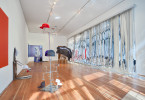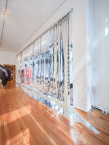Artspeak
Daniel Keyes
Dr. Daniel Keyes teaches English Literature and Cultural Studies with an emphasis on media studies at UBC Okanagan in Kelowna, British Columbia. His research reflects an interest in media and performance and is informed by his dissertation on the performance of testimonials on daytime talk shows in the mid-1990s. More recently his research focuses on the problematic expressions of cultural nationalism in 1950 and 1960s theatre productions throughout BC; television studies with a focus on reality TV; and contemporary articulations of whiteness in the Okanagan.
Exhibitions
-
ALEX DA CORTE
May 4–June 15, 2013In Bacon Brest, Alex Da Corte (Philadelphia) reconsiders the system of Hollywood through a revised version of “Six Degrees of Kevin Bacon”—a parlor game which proposes that anyone on earth is a mere six connections from the actor. Da Corte repositions players such as Martin Brest, Wes Craven, and Halle Berry’s Catwoman as central bloodlines of Hollywood, weaving through their varying careers to investigate the inconsistencies of Hollywood itself. Puncturing holes in its immaculate veneer, the artist posits that the structure of Hollywood is both faulty and essentially human, and the absorption of success and failure should instead be considered requisites for ingenuity and innovation beyond the cinema.
Da Corte creates sculptures out of repurposed materials collected from retail stores and various locales in his travels. He identifies his process as a form of cultural anthropology, utilizing modest, found materials that point to our intimate relationship with discardable items, asking us what these consumer objects reveal about our recent past and what direction we are headed. Toying with ideas of taste, Da Corte proposes that failure is in fact an essential component of risk and rule breaking; and the celebration and acknowledgment of flaws in a milieu that scorns and dismisses imperfection can resuscitate a vernacular from moments previous. His sculptures maintain traces of their past lives, reviving lost narratives while exposing the capacity of mass-produced objects to be surrogates for power, sex and happiness.





